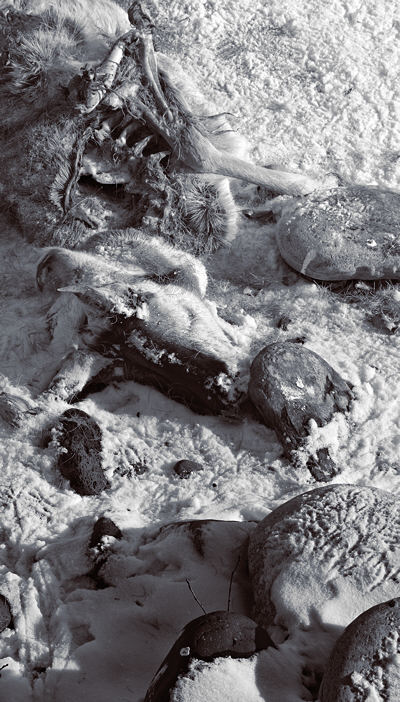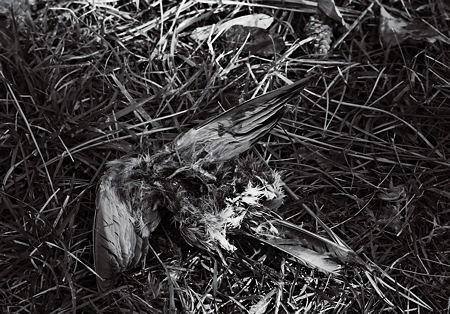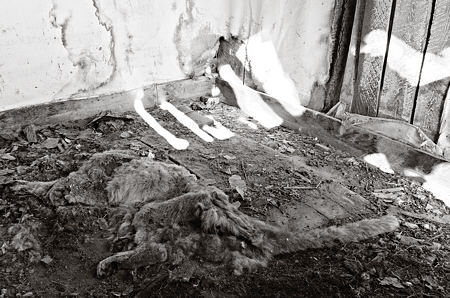If death is one of the great mysteries, it seems somehow unfitting that I most often simply stumble upon it. Last week, along a river bank where I was exploring for cottonwoods, I came across the remains of a pronghorn (antelope) on the shelf of ice at the edge of the water. They are quite commonly seen in the fields around there, but this was the first I’ve seen dead. My eye did not recognize at first what it was seeing among the stones and the crow tracks.

Last fall I walked into the back yard one early morning and found the remains of a robin, most likely another of Quark’s victims.

There are stranger cases. Also last fall I came across a dead mountain lion in a room of a long-abandoned house I had started to photograph. It took a moment to realize what I was seeing.

Why do I make these photographs of dead things? Unlike a jeweler I just met, who makes curiously lovely things from roadkill she picks up, I don’t feel I’m turning misfortune to beauty. If I had to put words to it, I guess I’d say that these photographs are paying attention, paying respect. I’m recognizing some significance in the event. Is it egotistical to imagine that matters?
Has death, ordinary or otherwise, entered your art work in some way?

Steve,
Death “ended” a work this past summer:
http://dearts.net/OurWalks.htm
It has not occurred to me to photograph the process of decay. But I do like the endproduct – a vertebrate column of a Wyoming buffalo graces the mantle piece in my living room
D.,
Your series is certainly about a lot more than mine is. One thing I feel it succeeds wonderfully at is conveying a sense of respect by the very fact that the photographs are taken in “ordinary” settings, and by passersby.
Steve,
If our little lives are measured between sleep and sleep (I can’t remember my Shakespeare, sorry) then what is evoked by you and D and Birgit, are your takes on the even smaller “life” of death. D takes us to the edge, you show the aftermath, and Birgit celebrates the clean picked bones that we all might hope for.
But what you keep coming across is a testimony to your unflinching confrontation with what’s out there. D., too, of course, but he is complying with a familial world, a world of old memories and new regrets and grief. But you are stumbling on that interim space before all the familiar is dissolved. It’s a tribute to your work as well as to the nature of existence.
Steve:
Your first and third images are all the more extraordinary for being so “ordinary”. One senses the remains as encased in a gathering dust of forgetfulness, and one finds a sort of withdrawal unaccounted for in any pictorial theory. But for awhile at least, a shock of hair will ruffle as though alive.
I sat earlier looking at these images with my head in my hands, my mind on course from past to future and back. The ruff of hair brought me to my childhood and the neighbor’s basement where the deer was to be slaughtered. I remember how pet-able the creature was in its death. Something about it demanded sympathy, perhaps respect for its elegance. But it was about to go through a transformation that was its lot, and soon enough would be a key component in somebody’s sloppy joe. That or otherwise food for a dog.